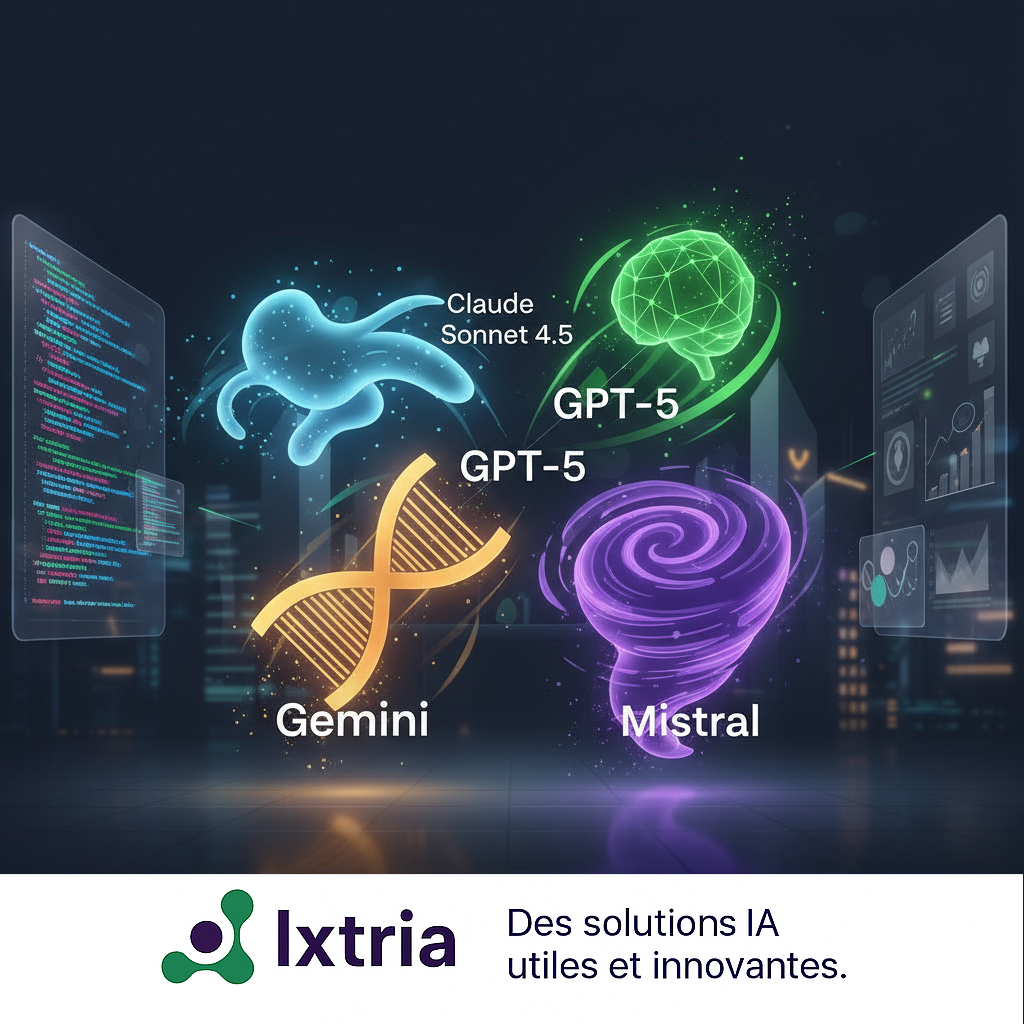Introduction
Artificial intelligence (AI) is experiencing a new revolution in 2025, driven by the arrival of Claude Sonnet 4.5 and fierce competition among tech giants. SMEs and decision-makers witness an avalanche of models, promises, and benchmarks. But which one to choose for your business? What concrete changes for the business world? This article offers an in-depth analysis of the latest advances, a rigorous comparison of leading models, and concrete recommendations for companies seeking to stay at the cutting edge.
Claude Sonnet 4.5 Innovations
Released in late September 2025, Claude Sonnet 4.5 marks a strategic turning point at Anthropic, aiming to deliver:
- Unmatched performance on coding tasks (SWE-bench: 77.2%), thanks to an advanced planning engine and enhanced autonomous agent execution capabilities
- Extended context of 200,000 tokens (several hundred thousand words), ideal for complex projects and voluminous documents
- Optimized memory and context management for AI agents capable of maintaining task continuity across extended sessions (via API or Amazon Bedrock)
- Agent excellence: ability to work autonomously for 30+ hours on real software development scenarios, according to product feedback and benchmarks
- Enhanced developer interface (VS Code, contextual API) and versioning tools (checkpoints for instant restoration)
Alignment and safety: Claude Sonnet 4.5 demonstrates progress against “sycophancy” risks, resistance to manipulation, and positive evaluation by reference authorities (UK/US AISI).
AI Competition Landscape
The LLM (Large Language Model) landscape evolves rapidly. In fall 2025, the main competitors are: Claude Opus 4.1 (Anthropic), GPT-5 (OpenAI), GPT-4o (OpenAI), Gemini 2.5 Pro (Google), and Mistral Large 2 (Mistral AI). Each brings distinct advantages:
| Model | Specialty or main advantage |
|---|---|
| Claude Sonnet 4.5 | Autonomous agents, intensive coding |
| Claude Opus 4.1 | Complex reasoning, critical management |
| GPT-5 | Speed, versatility, massive contexts |
| GPT-4o | API integrations, multimodality, stability |
| Gemini 2.5 Pro | Native multimodality (text, audio, image), context giant |
| Mistral Large 2 | Open-source performant model, efficiency |
Progress is accompanied by independent benchmarking growth (SWE-bench, MMLU, GSM8K) enabling objective positioning of each model in the field: complex coding, reasoning, multi-file analysis.
Why SMEs Must Take Notice
AI is no longer exclusively for large corporations. SMEs now have access to versatile, affordable offerings adapted to value creation in various contexts:
- Productivity: AI automates up to 45% of processes, according to Forbes, accelerating innovation and freeing teams from repetitive or administrative tasks
- Better-informed decisions: through massive data analysis, AI provides personalized recommendations, anticipates market trends, and identifies growth opportunities exploitable for SMEs
- Enhanced customer experience: AI chatbots, personalized content generation, and multilingual systems open doors to high-quality customer relationships, available 24/7
- Competitive advantage: early adoption of new models enables striking before competition, optimizing resources, and quickly adapting to a moving digital environment
Challenge: proper model selection at fair cost to maximize business benefit.
Comparison Methodology
To compare major 2025 LLMs, six criteria are retained:
- Input/Output Price ($/M tokens): usage cost, key for high volumes (automation campaigns, support, long document analysis)
- Context size: number of tokens processable in one session, decisive for managing large files, contracts, or multi-file IT projects
- SWE-bench performance (%): success rate on real software task benchmarks (development, code analysis/fixes) – practical value index for business automation
- MMLU performance (%): score on multithematic general reasoning benchmark – reflects model versatility across varied subjects (law, finance, science…)
- Strengths: specificities distinguishing the model and its typical applications (e.g., autonomous agents, multimodality, open-source)
- Safety & security (addressed in analysis section): system to reduce error risks or manipulation
Note: Scores come from latest benchmark publications, official documentation, and recognized third-party compilations (see sources at article end).
Model Comparison Table (2025) + Analysis
| Model | Input Price ($/M tokens) | Output Price ($/M tokens) | Context (tokens) | SWE-bench (%) | MMLU (%) | Strengths |
|---|---|---|---|---|---|---|
| Claude Sonnet 4.5 | 3.00 | 15.00 | 200K | 77.2 | 88.7 | Coding, autonomous agents |
| Claude Opus 4.1 | 15.00 | 75.00 | 200K | 74.5 | 86.8 | Complex reasoning |
| GPT-5 | 1.25 | 10.00 | 400K | 72.8 | 88.0 | Speed, versatility |
| GPT-4o | 5.00 | 15.00 | 128K | 54.6 | 87.2 | Mature integrations |
| Gemini 2.5 Pro | 1.25 | 5.00 | 2M | 67.2 | 85.0 | Massive context, multimodal |
| Mistral Large 2 | 2.00 | 6.00 | 128K | 65.0 | 84.0 | Open-source, efficiency |
Quick Criteria Analysis
- SWE-bench (%): Key indicator of the model’s ability to automate real coding tasks, crucial for tech SMEs, SaaS publishers, or IT services. Claude Sonnet 4.5 surpasses competitors with 77.2%.
- MMLU (%): Versatility score on non-tech subjects. High score indicates reliability on analytical or general writing tasks.
- Context (tokens): Maximum “memory” length of the model. Extended context favors large project management and giant document manipulation (legal analysis, finance, etc.), Gemini 2.5 Pro leading with 2 million tokens.
- Input/Output Price: Usage cost via API. Crucial for estimating profitability on large volumes. GPT-5 and Gemini 2.5 Pro appear most economical, Claude Sonnet 4.5 proves balanced in cost/performance for intensive use cases.
Note: Cost gap can be offset by better precision saving time, post-processing, or human intervention (e.g., manual correction avoided thanks to high SWE-bench).
Recommendations & Use Cases
Which Model for Which SME Profile?
- Claude Sonnet 4.5: reference for advanced automation (software development, long-term support, document generation/processing) and projects requiring autonomous agents
- Claude Opus 4.1: for detailed analyses, critical task management, and strict security requirements
- GPT-5: perfect for speed, versatility (text, code, images), and very high volume processing
- GPT-4o: recommended for existing integrations or environments requiring stability and interactions with other tools (API, vision, audio processing)
- Gemini 2.5 Pro: for SMEs with massive document processing needs, multimodal content (text, image, video), or wanting AI integration in Google Workspace suites
- Mistral Large 2: best choice for structures favoring open source, transparency, or having strong confidentiality constraints (self-hosting possible) and budget efficiency
Concrete Use Case Examples
- 24/7 Chatbots and customer service: Claude Sonnet 4.5 and Gemini 2.5 Pro — automatic generation of personalized responses, multichannel management
- Administrative task automation: GPT-5 or Claude, for automating sorting, synthesis, contract management, invoices
- Technical support / software publishing: Claude Sonnet 4.5, high SWE-bench, progressive integration into Dev team workflows
- Complex project management: Gemini 2.5 Pro, thanks to giant context and multimodal capability
- Marketing analysis and CRM automation: Mistral Large 2 or GPT-5, for speed and acquisition pipeline optimization
Conclusion & Opening: Staying Updated / Preparing Next Versions
The AI model race isn’t slowing down—quite the opposite! Each new version brings opportunities and use cases for SMEs. To stay ahead:
- Train business teams in regular AI usage and workflow adaptation
- Establish proactive monitoring (AI newsletters, benchmark sources, specialized forums)
- Regularly test new models on your own data and use cases to maximize value creation
- Subscribe to comparisons and reports that synthesize monthly evolutions and benchmarks (see CTA below)
Call to action:
Download the updated comparison table, subscribe to our newsletter to receive monthly comprehensive reports, and access the French version of this article upon request.
Sources
- What’s new in Claude Sonnet 4.5 – Anthropic
- Introducing Claude Sonnet 4.5 – Anthropic
- Claude Sonnet 4.5 – Anthropic Official
- How to Use Claude Sonnet 4.5 Across Tools and Platforms
- Getting Started with Claude 4.5: Beginner Guide
- What is Claude 4.5? Full Beginner’s Guide
- How AI Helps Small Businesses Compete with Big Organizations
- AI Adoption Rates in UK SMEs: 2025 Survey Insights
- How UK Small Businesses Can Safely Use AI in 2025
- 12 Best AI Tools for Small Businesses in 2025
- LLM Benchmarks: Overview, Limits and Model Comparison
- A Survey on Large Language Model Benchmarks
- 30 LLM evaluation benchmarks and how they work
- Benchmark Of OpenAI, Anthropic, And Google LLMs
- LLM benchmarks, evals and tests: A mental model
- LLM Performance Benchmarks – October 2024 Update


